| Pages:
1
2 |
4x4abc
Ultra Nomad
    
Posts: 4454
Registered: 4-24-2009
Location: La Paz, BCS
Member Is Offline
Mood: happy - always
|
|
El Marmol shipping route
which port did they use to ship the onyx from El Marmol?
When did they stop?
Harald Pietschmann
|
|
|
larryC
Super Nomad
   
Posts: 1499
Registered: 8-11-2008
Location: BoLA
Member Is Offline
|
|
I remember going to the west coast (just west of El Marmol) years ago I forget the name of the place but this was in the mid 70's and there were a few
large blocks of onyx laying on the beach left over from the mine. At least that is what the locals at the rancho said.
Off grid, 12-190 watt evergreen solar panels on solar trackers, 2-3648 stacked Outback inverters, 610ah LiFePo4 48v battery bank, FM 60 and MX60
Outback charge controllers, X-240 Outback transformer for 240v from inverters, 6500 watt Kubota diesel generator.
|
|
|
Mexitron
Ultra Nomad
    
Posts: 3397
Registered: 9-21-2003
Location: Fort Worth, Texas
Member Is Offline
Mood: Happy!
|
|
Santa Catarina I think. Or something else was shipped from there.
|
|
|
willardguy
Elite Nomad
     
Posts: 6451
Registered: 9-19-2009
Member Is Offline
|
|
https://www.bajabound.com/bajaadventures/bajafever/elmarmol....
|
|
|
David K
Honored Nomad
        
Posts: 65401
Registered: 8-30-2002
Location: San Diego County
Member Is Offline
Mood: Have Baja Fever
|
|
I took photos of the onyx blocks still at Santa Catarina in 2017. It's in my trip report, #4.
There are photos of the port in action from 100 years ago, too. When auto roads improved, then they switched to trucks. 1940s I would guess. The mine
shut down in 1958.
Her my El Mármol article on Baja Bound, published a few years ago: https://www.bajabound.com/bajaadventures/bajatravel/the_onyx...
From that article:
The process of mining the onyx was simple compared to the difficulty of transporting the heavy blocks to San Diego. The blocks were
originally taken by mule train to Puerto Santa Catarina, some 50 miles away. At that point, trucks with solid rubber tires would replace the mules.
Once they arrived at the beach, the blocks then were ferried through the surf to ships. As roads in Baja continued to improve, the blocks were
eventually trucked from the El Marmol all the way to San Diego.
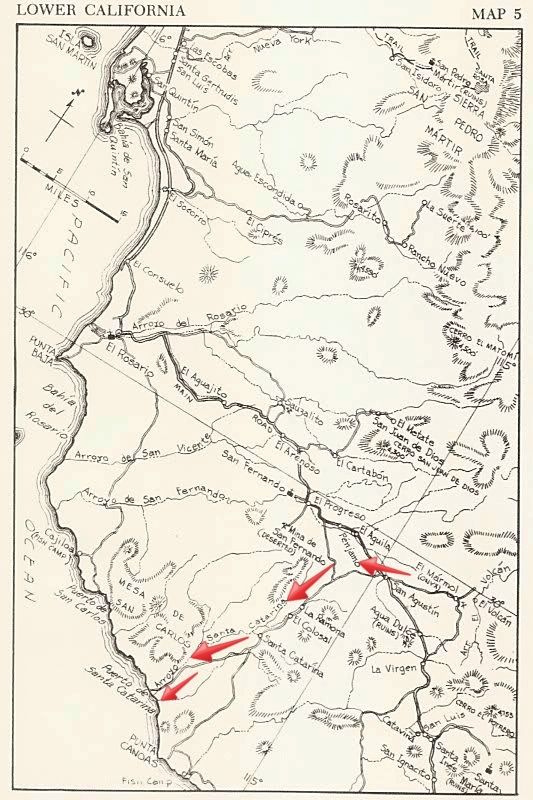
[Edited on 9-22-2017 by David K]
|
|
|
David K
Honored Nomad
        
Posts: 65401
Registered: 8-30-2002
Location: San Diego County
Member Is Offline
Mood: Have Baja Fever
|
|
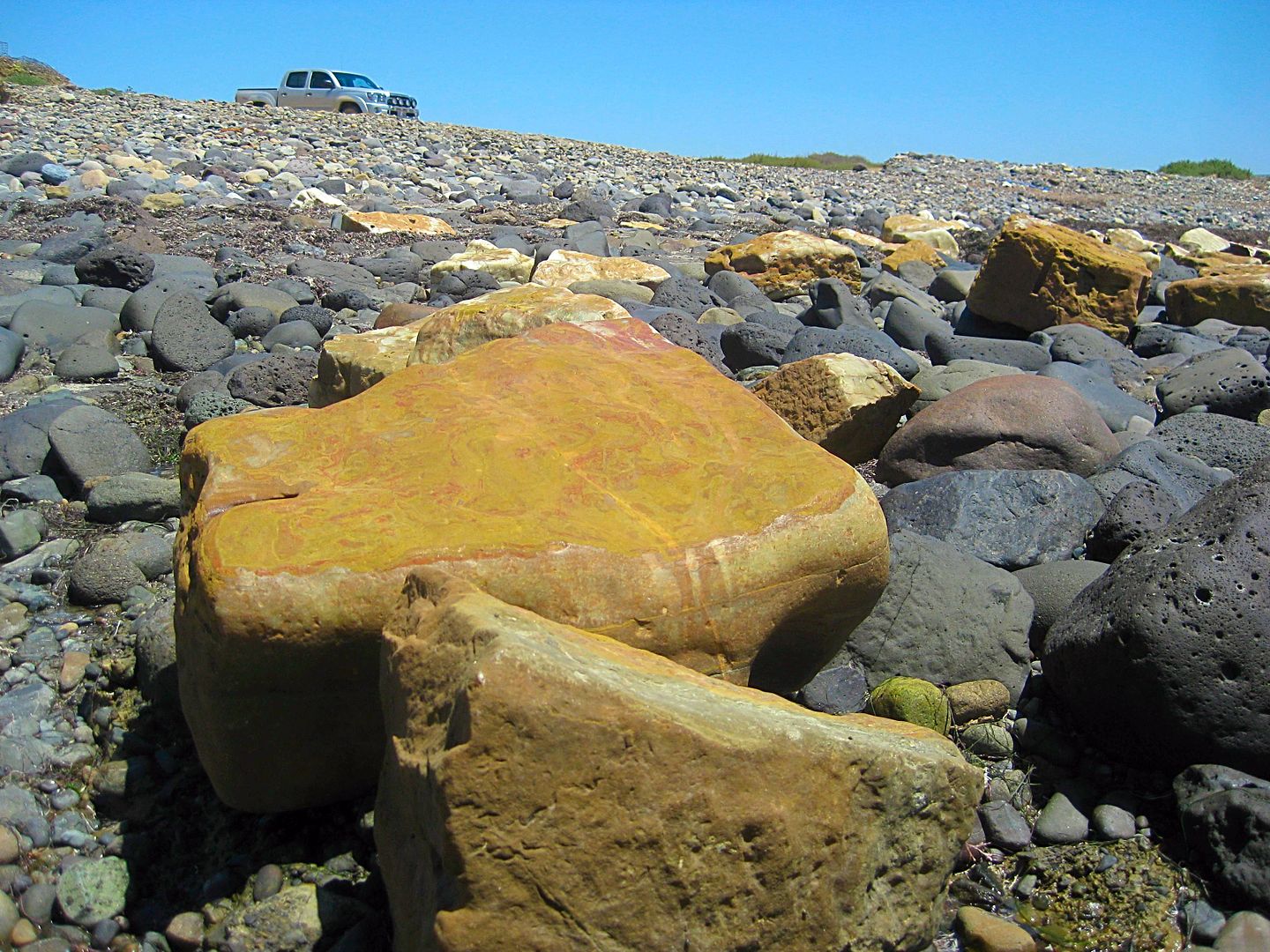
[Edited on 3-18-2022 by David K]
|
|
|
David K
Honored Nomad
        
Posts: 65401
Registered: 8-30-2002
Location: San Diego County
Member Is Offline
Mood: Have Baja Fever
|
|
Here is gureibo's post from 3/26/2015 that shows the onyx loading setup at Santa Catarina Landing, the early 1900s...
Quote: Originally posted by gueribo  | part 6

Derrick being used to lift onyx blocks into boats
The next stop was St. Augustine, twelve miles from the quarry. Here could be found good drinking and cooking water. The water at the onyx quarry
generally had such a high soda content that we used the water at St. Augustine -- hauling it back to camp in large wooden buckets.
The first view of the El Marmol onyx quarry was impressive. As you came over the summit of the surrounding hills a picture unrolled that was hard to
describe. The brilliant sunlight shining on exposed onyx transformed the great quarry into a field of glittering white. In the village, a tiny place,
the hundred or more employees were housed in buildings constructed by the company. When we were there we lived in a house built of onyx until the big
house was made ready for us.
The actual quarrying was the simplest part of the process in getting onyx from the quarries into a bonded yard at San Diego. The method used was
called the "wedge and feather." While much of the onyx lay exposed upon the surface a greater part was eight or ten feet underground buried beneath
masses of earth and rock, the accumulation of centuries. When this deposit had been removed holes would be drilled about every six inches and wedges
inserted in them. Upon driving in the wedge the block would split along the line of the drilled holes and could then be lifted by the derrick and
placed in position to be squared up.
Transporting the enormous blocks of onyx to the beach was a difficult and tedious haul. At first this was accomplished by means of mules. Sixteen
mules to a wagon could haul ten tons of onyx to the beach, returning with a cargo of food from the boat or perhaps coming back empty. A journey of one
hundred and ten miles, it took five days.
Because of the unfavorable coastline at Santa Catarina, vessels could not anchor close to shore so the onyx had to be conveyed out to them by means of
surf boats for a distance of some fifteen hundred feet. The huge blocks were taken from the pile at the beach and loaded onto hand cars and pushed out
to the end of the pier. Here the derrick came into use again by lifting blocks from the pier into ten ton lighter boats called pongos by the Mexicans
and built especially for this purpose. Pasqual Cajames was the best surf man my father had working for him. He was always in charge of the surf boats,
as he knew how to count the waves and how to pass through them.
Even in calm weather the surfing is a perilous task. Strong currents and high seas can stop the work for hours. In fair weather the average loading is
one-hundred and seventy-five tons in seven hours. A ship usually carried about six-hundred and fifty tons, so days would be spent at the beach. When
the onyx arrived in San Diego it was met by United States custom officials. Each block of onyx was unloaded, measured and consigned to the bonded yard
where it remained until sold. The bonded yard enabled the Pedrara Company to export to Canada, Australia and Europe as well as to the United States.
In the Spreckels Theater in San Diego, the entrance, lobby, walls and ceiling are entirely of Pedrara onyx. The soft glowing light shining through the
translucent onyx brings to mind childish dreams of a fairy palace -- forgetting all the hard work involved in quarrying and bringing the onyx here.
My travels in Baja California bring many things to mind. The long horseback rides over miles of untraveled country, the lovely wild flowers after a
rain, the strange cacti and trees to study, the rattlesnakes to make excitement, the gold, silver, copper, and onyx mines to learn about, the desert
winds, the wild surf and cool sea breezes to enjoy. One would look up at the golden moon and wonder about all that is good, getting nearer to God and
to nature and knowing there are many things which make one glad to be alive. The poet Rudyard Kipling perhaps said it best:
"Something hidden, go and find it.
Go and look behind the ranges
Something lost behind the ranges
Lost and waiting for you -- Go!" |
|
|
|
Sr.vienes
Nomad
 
Posts: 151
Registered: 7-23-2017
Member Is Offline
|
|
Several years ago I read part of one of mine manager Browns daughters family story that I believe she had written for one of the San Diego historical
Society's or something. Does anyone have a link to the complete story, it was fascinating and I would like to reread it.
|
|
|
David K
Honored Nomad
        
Posts: 65401
Registered: 8-30-2002
Location: San Diego County
Member Is Offline
Mood: Have Baja Fever
|
|
Quote: Originally posted by Sr.vienes  | | Several years ago I read part of one of mine manager Browns daughters family story that I believe she had written for one of the San Diego historical
Society's or something. Does anyone have a link to the complete story, it was fascinating and I would like to reread it. |
That is where gueribo got her posts from for this thread: http://forums.bajanomad.com/viewthread.php?tid=78240
|
|
|
4x4abc
Ultra Nomad
    
Posts: 4454
Registered: 4-24-2009
Location: La Paz, BCS
Member Is Offline
Mood: happy - always
|
|
cool stuff - thank you!
Harald Pietschmann
|
|
|
Pablito1
Junior Nomad

Posts: 68
Registered: 4-24-2011
Member Is Offline
|
|
In the early 1970s, probably 1971 I was at Papa Fernandez camp visiting and doing some diving. One morning there was a 3 axel truck parked at the
cantina. The truck had high sideboards, just a typical Baja truck of those times. Anyway in the truck was a large piece of marble. I didn't speak much
Spanish at that time so I never found out about the cargo at all of where it came from or where it was going.
On the right side rear axle the wheels had been removed because I suppose due to the heavy load the axle was bent.
Even to this day that is one thing that I still wonder about. Where did the marble come from and how did that axle bend?
Regards, Pablo
|
|
|
David K
Honored Nomad
        
Posts: 65401
Registered: 8-30-2002
Location: San Diego County
Member Is Offline
Mood: Have Baja Fever
|
|
Quote: Originally posted by Pablito1  | In the early 1970s, probably 1971 I was at Papa Fernandez camp visiting and doing some diving. One morning there was a 3 axel truck parked at the
cantina. The truck had high sideboards, just a typical Baja truck of those times. Anyway in the truck was a large piece of marble. I didn't speak much
Spanish at that time so I never found out about the cargo at all of where it came from or where it was going.
On the right side rear axle the wheels had been removed because I suppose due to the heavy load the axle was bent.
Even to this day that is one thing that I still wonder about. Where did the marble come from and how did that axle bend?
Regards, Pablo |
It was onyx (in Spanish there is no different word, so marble "mármol" is what is used.
There is an onyx mine near Gonzaga off the gulf road. See it shown here on the Cliff Cross 1970 map, arrow added to point it out:
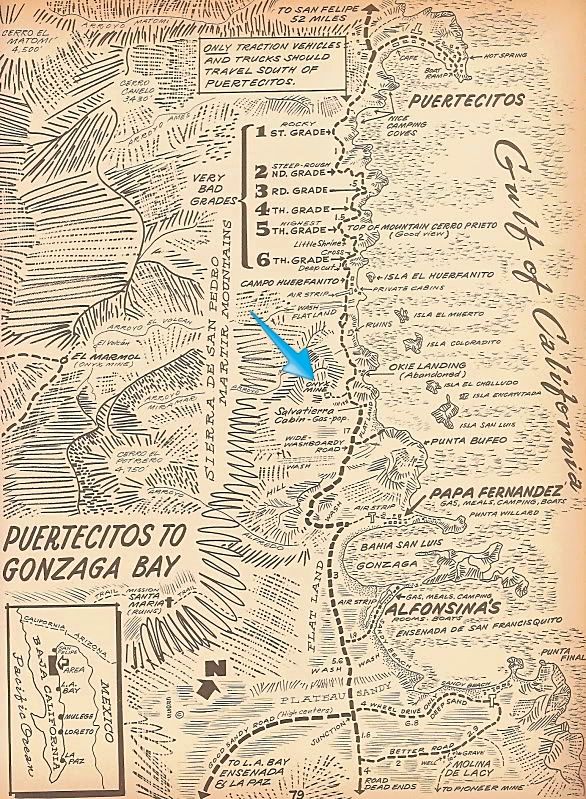
Plus, onyx is being created just west of Papa's. You can see the big white area from the beach by Rancho Grande where the mineral (soda/onyx) springs
are. There are (were) chunks of onyx there.
We read about this "Salt Spring" in the January 1959 issues of Desert Magazine, page 9: http://swdeserts.com/index_htm_files/195901-DesertMagazine-1...
As seen from the beach, view west:
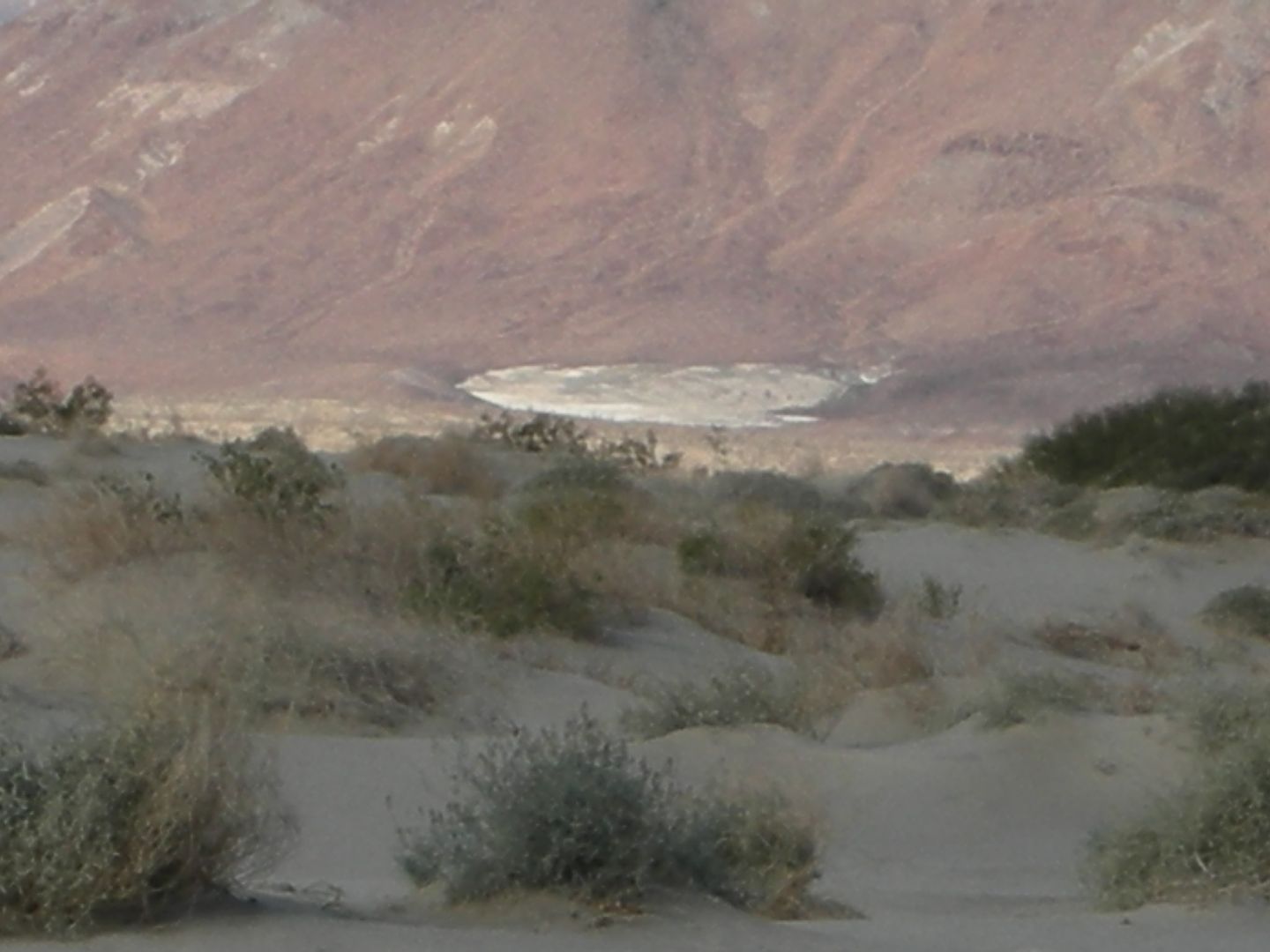
When I was there in 2002, view east:
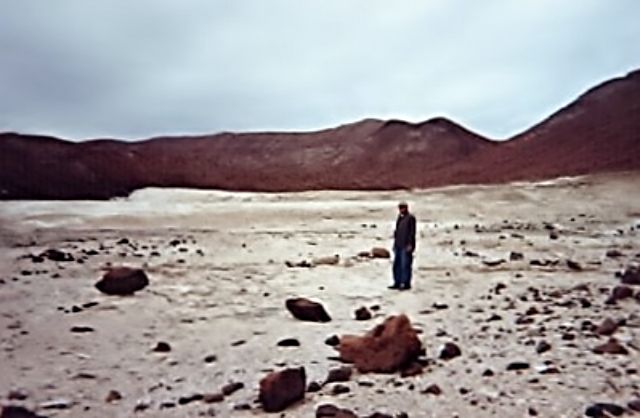
[Edited on 3-18-2022 by David K]
|
|
|
Pablito1
Junior Nomad

Posts: 68
Registered: 4-24-2011
Member Is Offline
|
|
I know about the mine near Okie's Landing. In fact I have a piece of onyx from that mine on my front porch.
What I have always wondered about was why was the marble at Papa's and even more strange to me is how could that axle get bent?
During a very hot time I was in San Felipe and somebody requested that I give a ride to a Mexican couple that was living at the mine. They evidently
had been gone from the mine for a while and their chickens had ran out of water. Upon arriving at the mine we found that several of the chickens had
tried to get water from a open top barrel and had fell in and drowned.
Regards
|
|
|
David K
Honored Nomad
        
Posts: 65401
Registered: 8-30-2002
Location: San Diego County
Member Is Offline
Mood: Have Baja Fever
|
|
The food at Papa's was better than Okie's Landing, perhaps? The truck most likely drove south from the mine and not north, because of the steep,
grades north of El Huerfanito, that probably prohibited passage with such heavy loads. Bouncing and overloaded was why an axle bends, I would think?
Great chicken story!
Near Okie Landing was a spring, Agua del Mezquitito, just a half mile up a canyon from the main road... Did you check it out?
I pointed it out on this map, as it was mentioned in one of the old Lost Santa Isabel Mission stories (the lost mission was 12 miles from the spring,
per the story and enforced our search at El Volcan arroyo back in 2011)...
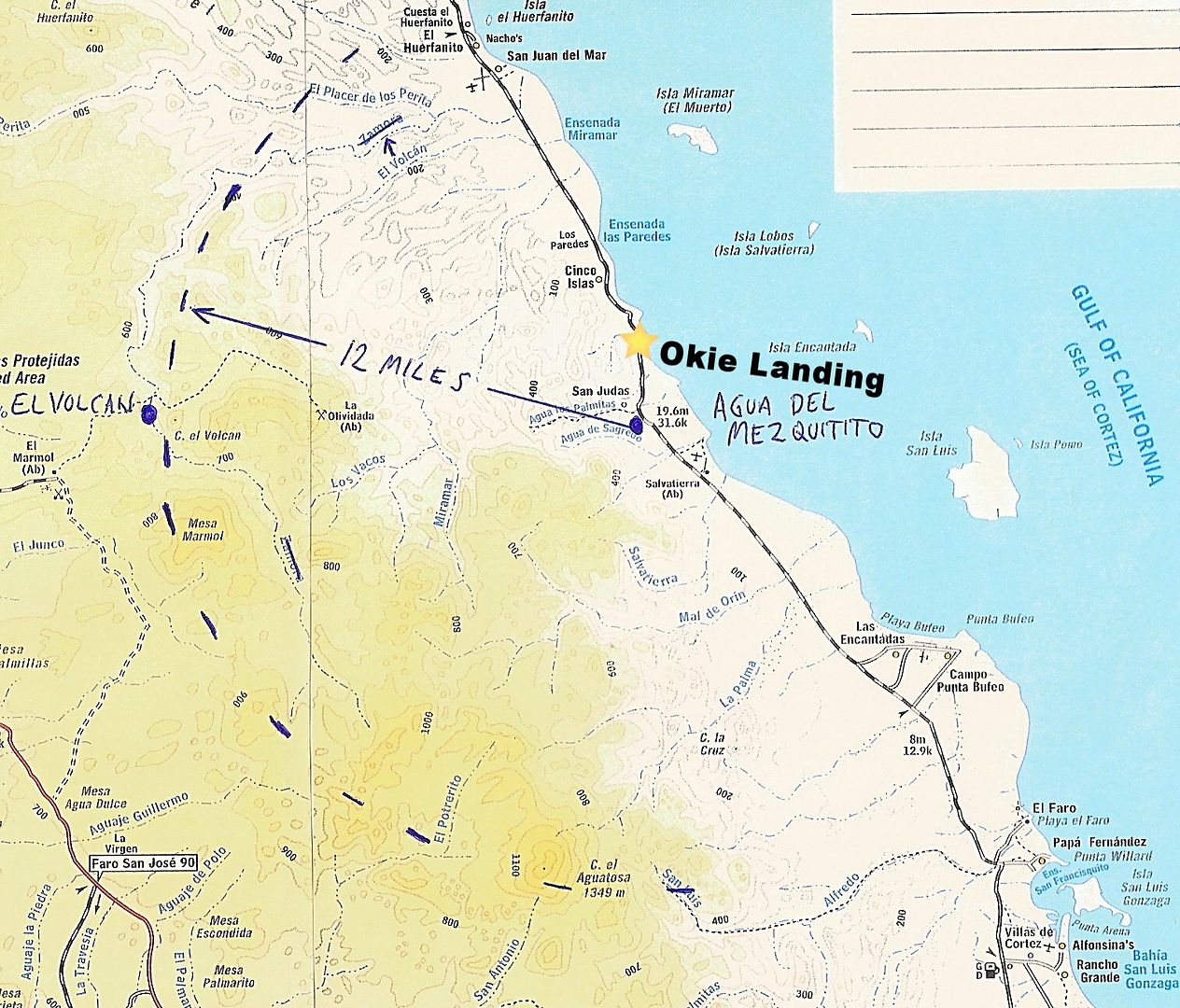
Here was Agua del Mezquitito in 1974...
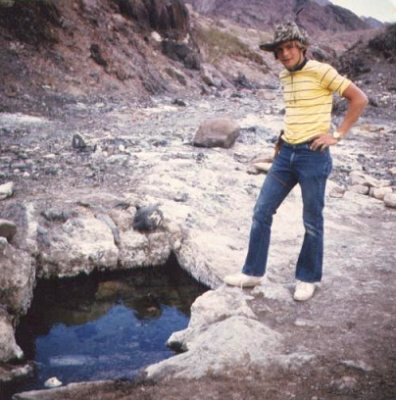
[Edited on 3-18-2022 by David K]
|
|
|
GregN
Nomad
 
Posts: 102
Registered: 5-13-2004
Location: Palm Springs
Member Is Offline
|
|
Thank you, Willardguy, for attaching my Baja Bound article. As I mentioned, it definitely was not easy getting the onyx to market.
|
|
|
David K
Honored Nomad
        
Posts: 65401
Registered: 8-30-2002
Location: San Diego County
Member Is Offline
Mood: Have Baja Fever
|
|
Most the onyx mines in Baja are called El Mármol or El Marmolito. The mine of El Mármol was called Onyx, but by Americans. I looked up mármol in a
Spanish dictionary and the English was both marble and onyx. So, while the word onyx may have a Spanish word, nobody in Baja seems to know or like it?
Thank you, however. I appreciate the correction.
|
|
|
Pablito1
Junior Nomad

Posts: 68
Registered: 4-24-2011
Member Is Offline
|
|
I for sure can't get in the discussion as to what to call it but my piece of marmol is about the size of a basket ball, is various colors and very
beautiful.
I worked and lived in Libya in the late 1970s and at that time there was lots of marble items in the high class stores. A person in one of those
stores [Michimalls] told me that onyx was the stage of the material before it turned into marble.
Other than that I don't know.
Regards
|
|
|
mtgoat666
Platinum Nomad
       
Posts: 20326
Registered: 9-16-2006
Location: San Diego
Member Is Offline
Mood: Hot n spicy
|
|
Onyx is a silicate, SiO2, a layered calchedony.
Marble is metamorphosed carbonate, CaCO3.
Woke!
Hands off!
“Por el bien de todos, primero los pobres.”
“...ask not what your country can do for you – ask what you can do for your country.” “My fellow citizens of the world: ask not what America
will do for you, but what together we can do for the freedom of man.”
Pronoun: the royal we
|
|
|
David K
Honored Nomad
        
Posts: 65401
Registered: 8-30-2002
Location: San Diego County
Member Is Offline
Mood: Have Baja Fever
|
|
Onyx is a higher grade, harder material than marble from what I remember reader years ago.
Lencho, nobody lives at the onyx mines. My name data comes from books and maps.
Mexican onyx is different from other kinds of onyx in the world.
My first visit to El Mármol was in 1974. The world's only all onyx schoolhouse was still intact and the door was locked. A couple years later, the
door was open. In 2000, after many years since my last visit, it was half destroyed. Sad, as there is plenty of onyx laying about.
|
|
|
PaulW
Ultra Nomad
    
Posts: 3113
Registered: 5-21-2013
Member Is Offline
|
|
So -- what is the access to the discussed Onyx mine like now that we have a superhighway with fencing?
|
|
|
| Pages:
1
2 |

